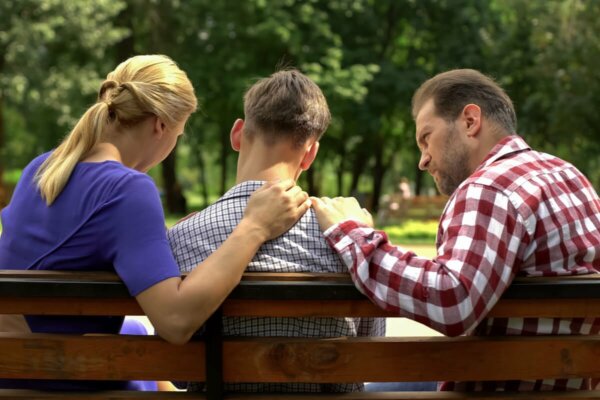How to Deal with High Conflict Teenagers

What exactly are high-conflict teenagers? What does this term even mean? Is there anything parents can do about it? There are many types of teen rebellion, such as defiance and disobedience. However, there are only two types of rebellion, roughly speaking.
The first type of rebelliousness appears around the preschool age and gradually increases during the evolutionary stage. In contrast, the second type appears beyond the age of ten and is usually related to the beginning of high school. In this last case, some environmental variables or hormonal changes could explain the conflictive attitude of the teenagers.
What you should know about high-conflict teenagers
Today’s article will offer some guidelines to interact with children or teenagers. Finally, we’ll describe a specific therapy that’s showing promising results in this population group.

Behavioral problems
Let’s answer the following questions before getting into the guidelines. How does a troubled teenager behave? You already read about rebellion above, which may manifest as aggression, lies, and disrespect, among other behaviors.
Keep in mind that teenagers are at a complicated stage on an emotional level because, in addition to the alteration of hormones that the arrival at this new stage implies, they’re undergoing important hormonal changes and a strong identity crisis.
Therefore, try to be cautious and empathetic when interacting with them, even if it isn’t always easy. However, keep in mind that serious cases might require professional help. Continue reading to find out how to detect them.
How to detect this behavior
Parents often are the ones who detect a change in behavior in their children. This translates, for example, into the rejection of certain activities or objectives that previously motivated them. Then, there are times when the conflict translates into strong opposition on the teenager’s part. It’s also quite easy to detect changes just by analyzing their behavior.
Regarding a higher level of conflict, some teenagers cause problems inside and outside their home. They may either get into trouble, feel lost, or have a serious identity crisis.
One can also detect these conflictive attitudes through lies, loss of hope, or sadness. This is important for parents to detect. This is because the young ones might be hiding other feelings such as fear, insecurity, loneliness, or sadness under their aggressiveness or rebellion.
Interacting with high-conflict teenagers
How should a parent interact with conflictive youngsters? Well, it depends on their role in their lives. That is to say, it isn’t the same to be their father, mother, brother, or sister than their psychologist or teacher.
The following are merely generic guidelines:
- Encourage spaces of communication with them.
- Work on your connection with them.
- Find out what’s happening to them (often, sadness lies behind aggressive behavior).
- Dedicate time to them.
- Negotiate with them.
- Don’t judge them.
- Set limits but be flexible.
- Use behavior modification techniques (this is important to reinforce appropriate behaviors).
- Strengthen their self-esteem, show them that you value them.
- Talk to them with empathy (put yourself in their shoes).
- Consult a specialist (especially in more serious cases).
- Be consistent.
- Lead by example.
Furthermore, some guides on teenager behavior propose a series of strategies focused on offering integral attention to them during a consultation. Mainly medical, although it could also be psychotherapeutic.
Some of them are:
- Respect for confidentiality. Everything that happens during a consultation should stay there (except in cases where the teenager is a risk to themselves or to others).
- Provide the adolescent with an intimate and safe space where they can freely ask questions and express doubts.
- Provide information about health resources and services available to them.
- Pay attention and show interest and respect for what they say in order to promote a therapeutic alliance.
- Explain their evolution and achievements, both to them and to their parents, promoting the responsibility of the teenager in the care of their own health.
- Finally, encourage teamwork with their family and educators in order to ensure multidisciplinary care.
Family psychodrama therapy based on scenes
Scene Based Psychodramatic Family therapy (SB-PFT) is an innovative intervention that’s beginning to show positive results in troubled adolescents. Specifically, professionals use it to improve personal relationships between troubled youngsters and their parents. It’s a type of therapy that integrates the principles of systemic family therapy and psychodrama through a multi-family group methodology.
A study published in the journal Family Process that was developed by Barbara Lorence, a researcher at the University of Huelva, evidenced the effectiveness of such intervention.
One of the keys to this methodology is that the teenage voice is very important. Moreover, different family systems intervene in the sessions with them as well. What’s the content of this therapy? Basically, two main themes:
- The conflict between parents and conflictive teenagers.
- The search for possible solutions to the conflicts.

Final reflection on high-conflict teenagers
This article contributed just some basic ideas on how to interact with high-conflict teenagers from a perspective of empathy and understanding. However, the issue is often a lot more complex than any scripts professionals may establish. As you may already know, adolescence is a complicated stage of life. People are still learning to manage it, and behavioral disorders or alterations, substance-related disorders (e.g. drugs), mood disorders, etc. may appear as a result of this and other factors.
Every disorder or problem will require specialized treatment. Thus, being there for them as parents or educators is both a challenge and a necessity. So approach your teen as a pal, as a helping hand, and as a motivator to help them fly. It’ll be very helpful in this process. Don’t forget that this important stage of life will define their identity.
What exactly are high-conflict teenagers? What does this term even mean? Is there anything parents can do about it? There are many types of teen rebellion, such as defiance and disobedience. However, there are only two types of rebellion, roughly speaking.
The first type of rebelliousness appears around the preschool age and gradually increases during the evolutionary stage. In contrast, the second type appears beyond the age of ten and is usually related to the beginning of high school. In this last case, some environmental variables or hormonal changes could explain the conflictive attitude of the teenagers.
What you should know about high-conflict teenagers
Today’s article will offer some guidelines to interact with children or teenagers. Finally, we’ll describe a specific therapy that’s showing promising results in this population group.

Behavioral problems
Let’s answer the following questions before getting into the guidelines. How does a troubled teenager behave? You already read about rebellion above, which may manifest as aggression, lies, and disrespect, among other behaviors.
Keep in mind that teenagers are at a complicated stage on an emotional level because, in addition to the alteration of hormones that the arrival at this new stage implies, they’re undergoing important hormonal changes and a strong identity crisis.
Therefore, try to be cautious and empathetic when interacting with them, even if it isn’t always easy. However, keep in mind that serious cases might require professional help. Continue reading to find out how to detect them.
How to detect this behavior
Parents often are the ones who detect a change in behavior in their children. This translates, for example, into the rejection of certain activities or objectives that previously motivated them. Then, there are times when the conflict translates into strong opposition on the teenager’s part. It’s also quite easy to detect changes just by analyzing their behavior.
Regarding a higher level of conflict, some teenagers cause problems inside and outside their home. They may either get into trouble, feel lost, or have a serious identity crisis.
One can also detect these conflictive attitudes through lies, loss of hope, or sadness. This is important for parents to detect. This is because the young ones might be hiding other feelings such as fear, insecurity, loneliness, or sadness under their aggressiveness or rebellion.
Interacting with high-conflict teenagers
How should a parent interact with conflictive youngsters? Well, it depends on their role in their lives. That is to say, it isn’t the same to be their father, mother, brother, or sister than their psychologist or teacher.
The following are merely generic guidelines:
- Encourage spaces of communication with them.
- Work on your connection with them.
- Find out what’s happening to them (often, sadness lies behind aggressive behavior).
- Dedicate time to them.
- Negotiate with them.
- Don’t judge them.
- Set limits but be flexible.
- Use behavior modification techniques (this is important to reinforce appropriate behaviors).
- Strengthen their self-esteem, show them that you value them.
- Talk to them with empathy (put yourself in their shoes).
- Consult a specialist (especially in more serious cases).
- Be consistent.
- Lead by example.
Furthermore, some guides on teenager behavior propose a series of strategies focused on offering integral attention to them during a consultation. Mainly medical, although it could also be psychotherapeutic.
Some of them are:
- Respect for confidentiality. Everything that happens during a consultation should stay there (except in cases where the teenager is a risk to themselves or to others).
- Provide the adolescent with an intimate and safe space where they can freely ask questions and express doubts.
- Provide information about health resources and services available to them.
- Pay attention and show interest and respect for what they say in order to promote a therapeutic alliance.
- Explain their evolution and achievements, both to them and to their parents, promoting the responsibility of the teenager in the care of their own health.
- Finally, encourage teamwork with their family and educators in order to ensure multidisciplinary care.
Family psychodrama therapy based on scenes
Scene Based Psychodramatic Family therapy (SB-PFT) is an innovative intervention that’s beginning to show positive results in troubled adolescents. Specifically, professionals use it to improve personal relationships between troubled youngsters and their parents. It’s a type of therapy that integrates the principles of systemic family therapy and psychodrama through a multi-family group methodology.
A study published in the journal Family Process that was developed by Barbara Lorence, a researcher at the University of Huelva, evidenced the effectiveness of such intervention.
One of the keys to this methodology is that the teenage voice is very important. Moreover, different family systems intervene in the sessions with them as well. What’s the content of this therapy? Basically, two main themes:
- The conflict between parents and conflictive teenagers.
- The search for possible solutions to the conflicts.

Final reflection on high-conflict teenagers
This article contributed just some basic ideas on how to interact with high-conflict teenagers from a perspective of empathy and understanding. However, the issue is often a lot more complex than any scripts professionals may establish. As you may already know, adolescence is a complicated stage of life. People are still learning to manage it, and behavioral disorders or alterations, substance-related disorders (e.g. drugs), mood disorders, etc. may appear as a result of this and other factors.
Every disorder or problem will require specialized treatment. Thus, being there for them as parents or educators is both a challenge and a necessity. So approach your teen as a pal, as a helping hand, and as a motivator to help them fly. It’ll be very helpful in this process. Don’t forget that this important stage of life will define their identity.
All cited sources were thoroughly reviewed by our team to ensure their quality, reliability, currency, and validity. The bibliography of this article was considered reliable and of academic or scientific accuracy.
- Araújo de Vanegas, A. M. (1998): La aventura de educar: Pubertad, Universidad de La Sabana, Santafé de Bogotá.
- Erikson, E. H. (2000): El ciclo vital completado, Paidós, Barcelona.
- Guía del adolescente. (2015). Grupo de Estudio del Adolescente Sociedad Andaluza de Medicina Familiar y Comunitaria. (Coord. Pérez Milena, A.).
This text is provided for informational purposes only and does not replace consultation with a professional. If in doubt, consult your specialist.







